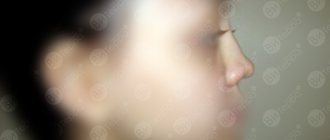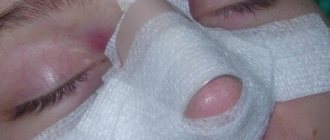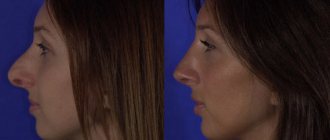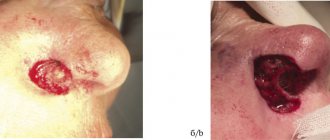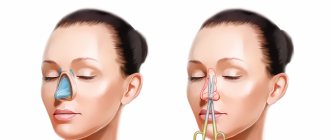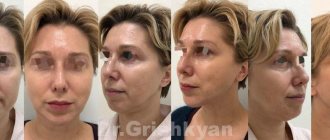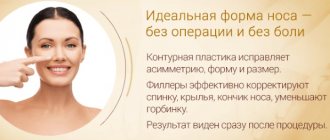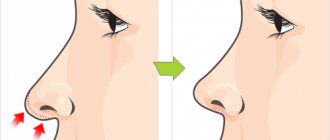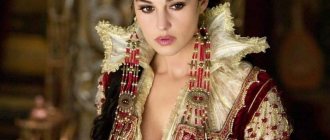Sign up for a free consultation
Secondary rhinoplasty (also called revision rhinoplasty) is performed to correct problems that remain after the primary intervention. If very often the reason for primary rhinoplasty is aesthetic problems, then revision rhinoplasty is directly related to health issues.
As a rule, revision rhinoplasty is performed because the first operation was unsuccessful. If the problem is a plastic surgeon’s mistake, then, of course, the patient prefers to see another specialist. And in this case, the choice of doctor must be especially careful: after all, the surgeon will have to operate with a lack of information. The fact is that after surgery, the condition of the tissue can change greatly, so revision rhinoplasty is an extremely delicate operation, the main task of which is to correct deficiencies while maintaining advantages.
But there are other reasons why rhinoplasty can be considered unsuccessful. First of all, this is the patient’s failure to comply with the doctor’s recommendations during the rehabilitation period. Accidental damage to the operated nose, caused by negligence, can negate the surgeon’s efforts, and instead of the attractive appearance that you already observed during computer modeling before plastic surgery, you can get a completely unpredictable result.
And finally, the third reason why patients sometimes seek revision rhinoplasty is subjective dissatisfaction with the results of the operation. Any plastic surgeon will tell you that you can evaluate the results of rhinoplasty no less than 6 months after it is performed. Any comparison of photographs before and after rhinoplasty (which is the most important argument) makes sense only after the end of the recovery period. But not every patient has the patience to wait for this moment. In particularly sad cases, no conversations with the doctor who performed the operation help, and the patient turns to another specialist with a demand to urgently correct the situation. However, revision rhinoplasty is also possible no earlier than six months after the initial operation, and no self-respecting surgeon will undertake to do it earlier.
In what other case will the doctor refuse to immediately perform revision rhinoplasty? If there are medical contraindications - for example, during exacerbation of certain diseases, during pregnancy.
There is another reason. A certain percentage of patients seeking rhinoplasty do not have problems with the shape of the nose at all, but purely psychological ones. A good surgeon will identify such a patient during the first consultations. But there are clinics that work on the principle of “any whim for your money.” In this case, the patient who has undergone plastic surgery remains dissatisfied with its results and turns to another rhinoplasty surgeon... If he has chosen a conscientious doctor, he will refuse to perform a repeat operation and will find a way to convince the patient to work with a psychotherapist.
Aesthetic problems: causes, solutions
Approximately 70% of patients who repeatedly seek help from a plastic surgeon complain of difficulty in nasal breathing.
However, the dominant motive for turning to a specialist is often an aesthetic rather than a functional problem. Hump after rhinoplasty . The process of regeneration of nasal bones goes through the phase of periosteal callus. If it develops excessively, a hump may appear on the back after healing. The hump should be considered as a complication; it is a sufficient reason for reoperation.
What provokes the development of massive callus? First of all, it must be said that callus is always formed, and it performs an important function. It tightens and holds damaged areas of the nasal skeleton, promoting their reintegration. A normal reaction differs from a complication only by the degree of development of the periosteal callus.
Insufficient bone fixation leads to excessive development of callus. The bones should be secured with a plaster cast (or plastic retainer), which is always applied to the nose and middle part of the face immediately after surgery. If the patient independently removes the plaster, “adjusts” it or moves it, the fixation of the osteochondral elements worsens. In this case, the body has no choice but to strengthen the fixation due to a powerful bone callus.
A hump on the nose after rhinoplasty often develops due to violation of the rules of the early rehabilitation period!
Other options for forming a hump are possible. Callus formation may be the result of an unfavorable process of bone regeneration and integration. Surgeon errors rarely lead to the formation of a hump; This usually happens after modeling the nose using cartilage transplantation when the graft is displaced.
To correct the defect, revision rhinoplasty is performed. The actions of the plastic surgeon are aimed at removing excess bone tissue formed on the bridge of the nose after the initial operation, or replacing a cartilage graft.
"Pit" on the back. The formation of a defect in the form of a saddle-shaped deformity can be caused either by non-compliance with rehabilitation rules or by a doctor’s mistake. It is right to talk about a surgeon’s mistake in cases where too much bone tissue or nasal cartilage was removed during the operation. Such errors occur both during aesthetic (bump removal, asymmetry correction) and functional (septoplasty, septum alignment) surgery.
Wearing glasses by the patient during the recovery phase is the second, more common cause of saddle deformity. We must never forget that the ban on wearing glasses is valid throughout the entire rehabilitation period! It is especially relevant in the first three months after plastic surgery! At this time, the elements of the nasal skeleton are extremely vulnerable, but some patients try to hide the “bruises” behind dark glasses after correction. It is unacceptable!
Revision rhinoplasty successfully solves the aesthetic problem. The operation can be performed using a closed approach, but many surgeons prefer to perform revision rhinoplasty using an open approach. To straighten the back, transplantation of a small fragment of cartilage tissue is used. Recovery after such operations is relatively quick, but rehabilitation rules must be followed. Otherwise, there is a high risk of resorption (destruction) of the cartilage graft or its displacement.
Beak deformity . A common problem that is diagnosed in approximately 50% of patients who visit the surgeon again. A beak-shaped deformity is manifested by an increase in the volume of the lower parts of the back and tip. Excess volume is located in the middle-lower part of the nose. The tip may be lowered (takes the shape of a hook) and thickened. The cause of deformation is often the peculiarities of tissue regeneration.
Persistent swelling after primary plastic surgery can also cause the development of this complication. What violations of the rehabilitation stage worsen the dynamics of healing and contribute to increased stagnation are described below in the text.
Tip drooping . A complication in the form of tip drooping is considered one of the direct indications for re-correction. The cause of the defect is a violation of the supporting function of the columella. This complication often develops after open plastic surgery, during which the structure of the columella, which performs a supporting function, is disrupted. To correct the defect, secondary rhinoplasty is used with the installation of a cartilage graft to enhance tip support.
Upturned tip of the nose. A complication in the form of an upturned tip develops after operations aimed at modeling the shape/volume of the tip or eliminating the hump. In both cases, the cause of the defect is excessive tissue removal. During tip surgery, the surgeon can remove excess alar cartilage. When correcting a hump, excessive correction leads to tissue tension, which results in upward displacement of the tip.
Revision rhinoplasty of the tip of the nose is performed using cartilage grafts. A plastic surgeon may use a variety of surgical techniques. A fragment of cartilage tissue can be installed in the back area; in this case, it acts as a spacer, which moves the raised tip down. Cartilage can also be implanted into the columella to compensate for volume deficits.
Thickening of the tip . Prolonged swelling after initial surgery can lead to persistent enlargement of the caudal dorsum and tip. To prevent complications, if the patient continues to experience congestion for a long time, the plastic surgeon must take measures aimed at reducing swelling. For this purpose, physiotherapeutic procedures (microcurrents) and local injections of hormonal drugs (Diprospan) are used.
From the point of view of preventing chronic edema, compliance with the requirements of the rehabilitation period is of great importance! The patient should exclude salty and spicy foods from the menu. It is important to avoid thermal procedures and physical activity, since all this leads to increased peripheral blood flow and increases congestion. Complete abstinence from alcoholic beverages is another effective measure to prevent edema and associated complications.
Secondary rhinoplasty is aimed at removing scar tissue. To perform the operation, the plastic surgeon uses closed or open access.
Step deformation . The reason for the appearance of stepwise deformation is most often the incomplete integration of the cartilaginous and bony parts of the nasal skeleton after rhinoplasty. As a result of incomplete integration between the cartilage and the bone, a gap is formed, which externally appears as a “step” in the middle third of the back. Such a complication can be caused by a surgeon’s mistake, a patient’s violation of rehabilitation rules, or the inferiority of regenerative processes.
Curvature, asymmetry of the nose . This aesthetic complication can be caused by surgeon errors, regeneration features, or the patient’s careless attitude to the requirements of rehabilitation. The curvature can be the result of uneven removal of tissue on the left and right sides, asymmetrical graft installation, displacement of the cartilage graft, partial resorption of the graft, and excessive callus formation on one side.
Before performing a second operation, the plastic surgeon finds out the cause of the complication, and then forms a strategy for surgical correction.
Piezosurgery technique
In surgical practice, rhinoplasty using a piezo apparatus is most often performed under general anesthesia. At the initial stage, the surgeon peels off the skin at the base of the nasal septum. To do this, a small incision is made to provide access to the bone structures. Depending on the purpose of rhinoplasty, the shape of the nose is modeled, its angle is changed, or excess parts of bone and cartilage tissue are cut off. The progress of the operation is carefully monitored by the surgeon using a three-dimensional image on the screen, which shows where the tip of the knife is located. Vascular trauma is virtually zero, since the ultrasonic piezo knife glues small vessels together, reducing the amount of swelling and bruising, making the result of the operation more accurate and elegant. As a rule, aesthetic surgeries last no more than 2 hours; reconstructive surgery can take up to 4 hours.
Functional complications of rhinoplasty
The main functional complication is chronic nasal congestion. The timing of recovery of external respiration after surgery varies. In some patients, breathing is restored after removing tampons or silicone inserts from the nasal passages. In some patients, breathing is restored after the cast is removed. The end of the early postoperative period is another control point at which many people regain breathing through their nose.
If breathing has not recovered after six months, it is reasonable to talk about the development of a complication. A functional complication can result from an incorrect choice of correction strategy (complete removal of the cartilaginous part of the septum, lack of manipulation of the maxillary bone, etc.). Difficulty breathing is often caused by non-compliance with rehabilitation rules: sneezing with your mouth closed, blowing your nose, wearing glasses. These errors increase the risk of perforation, curvature, and mobility of the nasal septum.
The category of complexity of revision rhinoplasty is largely determined by the cause of the functional complication. If the correction is insufficient, the plastic surgeon in the reoperation completes what was not done during the primary plastic surgery. Perforation of the nasal septum can often be corrected with a simple procedure that is not revision rhinoplasty. It is more difficult to operate if too much tissue was removed during the first correction. In this case, transplantation has to be used.
Rehabilitation
The recovery period also does not last long. In just a day (in rare cases, two days), patients are sent home. After a week, the stitches are removed. Bruising and swelling disappear within 7 to 10 days from the date of surgery. To avoid traumatic effects on the nose during this time, the patient wears internal splints and a protective plate.
In the photo: Results of rhinoplasty using a piezo apparatus on the 10th day after surgery.
Prices
| Type of service | Service cost |
| Revision rhinoplasty | 260,000 rub. |
| Rhinoplasty | 200,000 rub. |
| Rhinoseptoplasty | 260,000 rub. |
| Surgical correction of nasal tip deformity, category 1 | 110,000 rub. |
| Surgical correction of nasal tip deformity, category 2 | 120,000 rub. |
| Surgical correction of the wings of the nose, category 1 | 70,000 rub. |
| Surgical correction of the wings of the nose, category 2 | 75,000 rub. |
| Surgical correction of the nasal septum, category 1 | 50,000 rub. |
| Surgical correction of the nasal septum, category 2 | 60,000 rub. |
Show all price
ANOTOMIC ANALYSIS OF THE NOSE
A detailed anatomical analysis of the nose is the first important step in achieving a successful surgical outcome. Analysis of the nose during revision rhinoplasty is complicated by changes in anatomical structures from previous operations.
In cases of deviated septum, septoplasty is performed. The procedure includes: resection of the septal cartilage, application of incisions, application of corrective sutures, installation of cartilage strata.
A significant factor influencing the result is the skin - its thickness, elasticity, integrity, mobility in relation to the main nasal structures. Then the nose bones, the position and size of the bones. The nasal bones are palpated to identify any abnormalities, irregularities, or asymmetries. For the tip, the cartilages that form it are studied and evaluated - symmetry, projection, and relationship with the columella are examined.
Revision rhinoplasty price at the Doctor Grishkyan clinic in Moscow
Since revision rhinoplasty is always more difficult to perform and difficult to predict in terms of results, the cost of such plastic surgeries is on average higher than primary ones. Often there is a need to perform reconstruction using implants, which makes it possible to restore the structures of the nose. The cost of revision rhinoplasty in Moscow is determined by the status of the clinic, the experience and qualifications of the plastic surgeon, the volume of upcoming manipulations, anesthesia, preoperative examination and postoperative observation. Thus, the need for revision rhinoplasty arises in cases where a person has already had a nose correction, but was dissatisfied with the result. In most cases, an experienced surgeon is able to solve the problem and correct defects through minimal surgical intervention.
Revision rhinoplasty
| Operation name | Cost in rubles |
| Revision rhinoplasty | 400000 |
Nose job price
